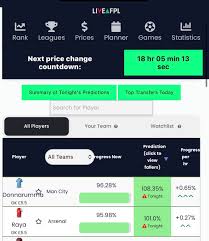Understanding FPL Price Changes in the 2023 Season

Introduction to FPL Price Changes
As Fantasy Premier League (FPL) season progresses, price changes are a crucial aspect for managers to keep in mind. These fluctuations can significantly affect team composition and strategy, making it imperative for players to stay updated on the latest price changes to optimise their squads. Throughout the season, players’ prices can rise or fall based on their performance, popularity, and overall demand among FPL managers.
Recent Trends in Price Changes
Starting with the recent events this season, several high-performing players have seen their prices soar. For instance, standout performers like Erling Haaland and Mohamed Salah have experienced upward price adjustments due to their consistent scoring and high ownership rates. According to the latest data, Haaland’s price skyrocketed to £14.0, reflecting his role as a pivotal asset for many FPL managers.
Conversely, players who have underperformed or have suffered injuries have witnessed downward price adjustments. Notably, several premium players, including the likes of Harry Kane, have seen their values dip in response to on-field performances. As of mid-October 2023, there has been a noticeable trend where the once popular assets are being reassessed, prompting managers to make tactical transfers.
Factors Influencing Price Changes
FPL price changes are influenced by a combination of factors. The primary determinant is player performance which directly correlates with points earned in the game. Furthermore, ownership statistics play a vital role; players with high ownership are more likely to see price increases as more managers buy them. Alternatively, if a significant number of managers sell a player, their price will likely decrease.
Additionally, form, injuries, and transfers also impact price changes. Injured players that are sidelined for an extended period experience significant price drops, creating opportunities for managers to buy them at a lower price upon return.
Conclusion and Outlook
As the FPL season unfolds, understanding and monitoring price changes can offer a competitive edge. Managers must adopt a proactive approach—keeping an eye on trends while making informed decisions about their squads. The fluctuations in player prices can often signify deeper narratives in the league, affecting overall team strategy. Looking forward, it is advisable for players to analyse players’ performances, injury updates, and fixture schedules to take advantage of price changes effectively. This season promises to be dynamic, with price volatility likely to continue shaping the FPL landscape as teams compete fiercely.
